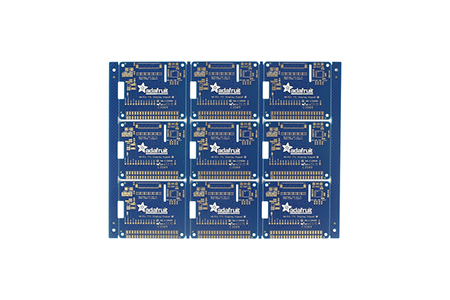FR4 PCB material is the most widely used substrate in rigid circuit boards, prized for its flame resistance (FR), electrical insulation, and cost efficiency. Over 90% of consumer electronics rely on this glass-reinforced epoxy composite, but its limitations in high-frequency applications demand careful consideration.
This guide explores FR4’s composition, optimal thickness selection, and when to switch to high-performance alternatives. Whether you’re designing IoT devices or RF systems, understanding FR4’s trade-offs ensures optimal PCB performance.

FR4 is a composite material consisting of woven fiberglass cloth bonded with flame-retardant epoxy resin. The "FR" stands for Flame Retardant (meeting UL94 V-0 standards), while the "4" denotes the specific grade within this class. This combination creates a rigid substrate with excellent electrical insulation and mechanical stability.
Below are the key technical specifications of standard FR4 material:
| Property | Typical Value | Notes |
|---|---|---|
| Glass Transition Temp (Tg) | 150Tg-170Tg | Higher Tg versions (170°C+) available |
| High Decomposition Temperature | >345 ℃ | Critical for high-voltage applications |
| Laminate Thickness Range | 0.2mm - 3.1mm | Ultra-thin for flex applications |
| Dielectric Constant (@1 GHz) | 4.25-4.55 | Varies with frequency |
| Dissipation Factor (@ 1 GHz) | 0.016 | Higher than high-frequency laminates |
FR4 serves as the fundamental building block in PCB construction, forming the rigid insulating substrate that supports and interconnects electronic components. In a standard PCB stackup, FR4 acts as the dielectric core between conductive copper layers, with its thickness and properties directly influencing the board's electrical and mechanical performance.
The manufacturing process begins with copper-clad FR4 laminates, where thin copper foil is bonded to one or both sides of the substrate. Through photolithography and etching, these copper layers are patterned into precise conductive traces. Multilayer boards are created by stacking and laminating multiple FR4-copper layers under heat and pressure, with prepreg (pre-impregnated) FR4 material serving as the adhesive between layers.
FR4's versatility makes it suitable for various PCB types, from simple single-sided boards in consumer electronics to complex multilayer configurations in industrial controls. Its dielectric properties allow controlled impedance routing for digital signals, while its thermal stability supports soldering processes. The material's machinability enables precise drilling for vias and through-holes, essential for creating vertical interconnections in modern high-density designs.
Selecting the optimal FR4 thickness is critical for PCB performance and reliability. The standard 1.6mm thickness works for most applications, but specialized designs require careful consideration of these key factors:
Space Constraints: Thinner boards (0.2-0.8mm) are essential for compact devices like wearables, while thicker substrates (2.0-3.0mm) provide structural rigidity for large-format boards.
Impedance Control: High-speed designs demand precise dielectric thickness to maintain target impedance values, with thinner FR4 allowing tighter trace width control.
Mechanical Requirements: Thicker substrates (≥2.0mm) better withstand vibration and mechanical stress in automotive/industrial applications.
Component Compatibility: Through-hole components and connectors often require specific board thicknesses for proper pin engagement and solder joint formation.
Thermal Management: Thicker FR4 provides better heat dissipation for power electronics, though metal-core boards may be superior for extreme thermal loads.
Manufacturing Considerations: Very thin boards (<0.4mm) require special handling during fabrication and assembly to prevent warping or breakage.
For high-frequency applications, remember that FR4's dielectric constant varies slightly with thickness, potentially affecting signal integrity in sensitive designs. When in doubt, consult your PCB manufacturer early in the design process to balance electrical, mechanical and cost requirements.
When designing PCBs for demanding applications, engineers must choose between standard FR4 and specialized high-frequency laminates. This critical decision impacts performance, reliability, and cost. Below we compare these materials across essential parameters:
| Parameter | Standard FR4 | High-Frequency Laminates (e.g., Rogers, Taconic) |
|---|---|---|
| Cost | $ (Most economical) | $$$ (3-10x more expensive) |
| Dielectric Constant (Dk) | 4.3-4.8 (varies with frequency) | 2.2-10 (stable across frequencies) |
| Loss Tangent (Df) | 0.02 (higher signal loss) | 0.001-0.004 (minimal signal loss) |
| Frequency Range | <1GHz (best performance) | Up to 77GHz+ (5G/mmWave applications) |
| Thermal Stability | Moderate (Tg 130-140°C) | Excellent (Tg often >280°C) |
| Moisture Absorption | 0.1-0.2% | <0.02% (superior humidity resistance) |
| Typical Applications | Consumer electronics, industrial controls | 5G antennas, radar systems, satellite comms |
Cost-sensitive projects
Digital/low-frequency analog circuits (≤500MHz)
Standard operating environments
High-volume consumer products
Millimeter-wave applications (24GHz+)
Critical impedance control requirements
Extreme temperature/humidity conditions
Low-loss signal transmission needs
For hybrid designs, consider using FR4 for the main board with high-frequency laminates only in critical RF sections - this balances performance and cost effectively.
While FR4 remains the workhorse of PCB materials, engineers should be aware of its evolving capabilities and limitations in advanced applications:
Modern FR4 variants now address specific design challenges. High-Tg versions (170°C+) withstand higher soldering temperatures, while low-loss formulations improve high-frequency performance. For cutting-edge applications, hybrid designs strategically combine FR4 with specialized laminates - using premium materials only where absolutely necessary.
These developments allow FR4 to maintain its cost advantage while meeting increasingly demanding requirements in automotive, industrial, and communications equipment. Understanding these advanced options helps designers make informed material selections without over-engineering their solutions.
Are you considering how to produce a quality PCB that meets your required needs? Then, FR-4 PCB material is the best material you need. It is suitable for different applications, including the production of multi-layer boards.
Kindly contact us for a quality product that meets your needs. We are available to supply any quantity of FR-4 that you need for your projects. Click here to check our quality products.
By continuing to use the site you agree to our privacy policy Terms and Conditions.
Recruit global agents and distributors Join us